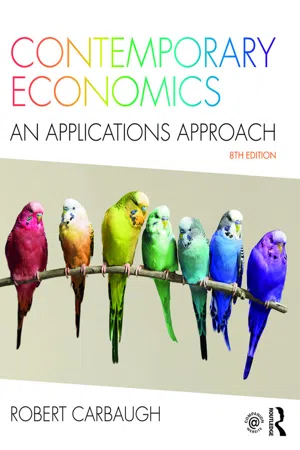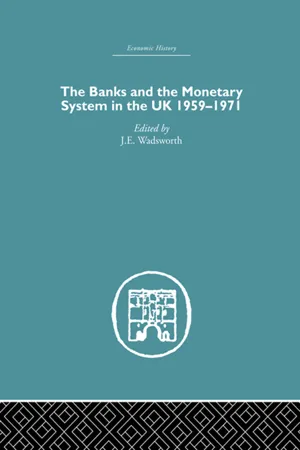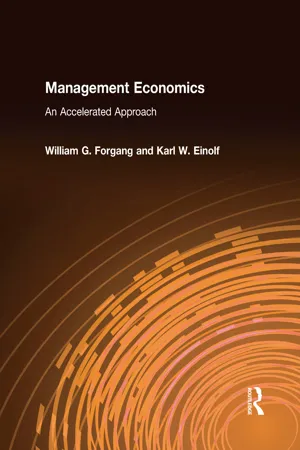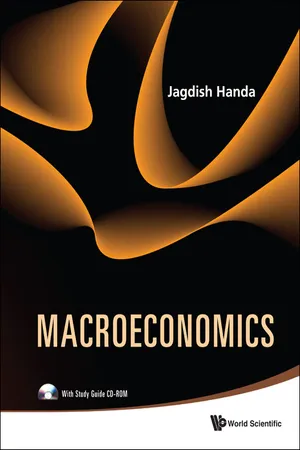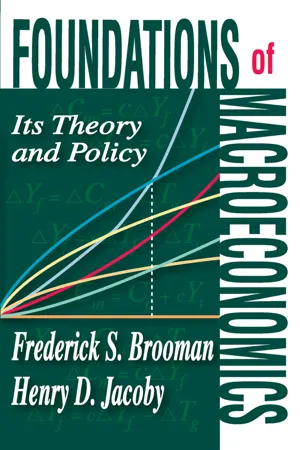Economics
US Money Supply
The US money supply refers to the total amount of money in circulation within the economy, including cash, coins, and various types of bank deposits. It is a key indicator for understanding the overall health and stability of the economy, as changes in the money supply can impact inflation, interest rates, and overall economic activity. The Federal Reserve closely monitors and manages the money supply to achieve its economic objectives.
Written by Perlego with AI-assistance
Related key terms
Related key terms
1 of 4
Related key terms
1 of 3
7 Key excerpts on "US Money Supply"
- eBook - ePub
- W. Charles Sawyer, Richard L. Sprinkle(Authors)
- 2020(Publication Date)
- Routledge(Publisher)
2 Internationally, this definition of the money supply is known as narrow money.Other definitions of money are possible. There are a number of financial assets that are referred to as near monies that can be used as money in many circumstances. Near monies are highly liquid financial assets such as savings accounts, time deposits, and short-term government securities. In many cases, these assets cannot be spent as easily as can currency or a demand deposit at a local bank. An example of a near money is an account with a money market mutual fund. In the U.S., this is a common form of near money. In other countries, where this form of near money is less common, a large amount of near money is held in the form of time deposits. For the most part, near monies do not function as a medium of exchange but they can be readily converted into currency or demand deposits. For the U.S., M1 plus money market mutual funds and time deposits constitutes M2. In an international context, the term for M2 is called broad money.Ultimately, the supply of money within a country is the result of a process that we need to describe. In order to do this we will need to look at an important part of the money supply known as the monetary base (B). The monetary base (B) is composed of cash in the hands of theBOX 15.1WHAT IS THE SUPPLY OF MONEY?Even though the public can hold money for a variety of reasons, the supply of money that is relevant for the purposes of economic policy is a measure of money that will be used for economic transactions within a given period of time, such as a year. Unfortunately, in most countries such a perfect measure of the money supply does not exist. For example, in the U.S. neither M1 nor M2 is identical to the supply of money the public uses for short-run economic transactions. The primary reason why this is true is related to the existence of money market mutual funds. These funds can be used for transactions, as each account has limited check-writing capabilities. In addition, these accounts are also widely used as a parking place for funds between the purchase and sale of equities, bonds, and other long-term financial assets. As a result, M1 understates the amount of money that the public could use for short-run economic transactions, and M2 overstates this same amount. In this case, the central bank of the U.S. cannot know with certainty what the amount of money is that the public intends to use for short-run economic activities. To a greater or lesser extent, every country has this problem of defining what the relevant supply of money is. In the discussion that follows, we assume that there is a relevant supply of money under the central bank’s control. However, one should keep in mind that the supply of money in an economy is not as clear-cut in most cases as central bankers or those following the state of the economy might like. - No longer available |Learn more
Contemporary Economics
An Applications Approach
- Robert Carbaugh(Author)
- 2016(Publication Date)
- Routledge(Publisher)
However, defenders of the American penny maintain that its abolishment would result in problems. They fear that if the penny is eliminated, consumers would be hit with a rounding tax, since merchants would tend to round upward rather than downward. They also note that the penny aids causes in raising hundreds of millions of dollars each year for important charities like Ronald McDonald House Charities, School and Youth Programs, and the like. Moreover, the U.S. Mint’s fixed costs would continue to be incurred whether or not the mint produces the penny; these costs would be absorbed by the remaining denominations of circulating coins, without the penny adding to their production costs. Finally, if pennies were eliminated, Americans would switch to using the nickel which cost about 9 cents to manufacture in 2015. Would the government really be saving money by eliminating the penny?To date, the U.S. government has said that it needs more research before it can make a decision to either change the composition of the penny so as to include cheaper metals than zinc or copper or do away with the penny altogether.Sources: U.S. Mint, Annual Report, 2015; “Canada Drops Penny from its Currency,” Chicago Tribune, February 5, 2013; “Canadian Penny Discontinued,” The Huffington Post, February 4, 2013.Measuring the Money Supply: The M1 Money Supply
So far in this chapter, we have discussed many forms of money. Let us now consider how the money supply is measured in the United States.There are two approaches to defining and measuring money: the narrow definition of the money supply, which emphasizes the role of money as a medium of exchange, and the broader definitions of the money supply, which emphasize the role of money as a temporary store of value.Table 14.3 The M1 Measure of U.S. Money Supply, 2015Component In billions of dollars ($) Percent of Total Currency 1,309.0 43 Demand deposits 1,231.2 40 Other checkable deposits 506.6 17 Traveler’s checks 2.6 – Total 3,049.4 100 Source: Federal Reserve Board, Money Stock Measures, September 17, 2015, available at www.federalreserve.gov .Table 14.3 lists the components of the U.S. money supply according to its narrowest definition, the M1 money supply. This measure of the money supply includes currency in the hands of the public, demand deposits, other checkable deposits (NOW and share draft accounts), and traveler’s checks. M1 is expressed by the following formula:M1 = Currency in the hands of the public + Demand deposits + Other checkable deposits + Traveler’s checksIn our definition of money, we include currency only if it is in the hands of the public. - J.E. Wadsworth(Author)
- 2013(Publication Date)
- Routledge(Publisher)
In particular, let us add, money supply in Britain has to be considered in the environment of UK financial institutions, especially banks. If the money supply is important, it is presumably because of its relationship to aggregate demand. As the Radcliffe Committee put it, the ‘relevance of the availability of funds to the pressure of total demand is what lies behind the supreme importance which is often attached to “the supply of money”’. A clear distinction needs to be drawn between the stock of money and its flow, and until recently attention has been directed almost entirely at the effects of the flow. Today it is being increasingly suggested that attention should be paid to the stock, and in particular to changes in the stock.In discussing the money supply, however, a satisfactory definition is a first essential. In one sense an appropriate definition depends upon the context in which money supply is to be considered. If related to aggregate demand, the definition has to be concerned with the spendability of money. Thus it should be associated primarily with money in the sense of something that can be spent immediately, as contrasted with near-money, which is moderately liquid but cannot be used directly for spending by the holder. An example of near-money would be funds deposited with a building society or similar undertaking. Much near-money is readily spendable, though not normally directly or immediately as with currency and most bank deposits, but only after some other operation to turn it into one of those forms. Moroever, as we shall see, if it is turned into spendable money it does not increase the total of final means of payment – that is to say, the ‘active’ money supply.In International Financial Statistics , published by the International Monetary Fund, money is by implication defined as currency and bank deposits, the figures for the United Kingdom including balances on deposit as well as current accounts. ‘Quasi-money’ – that is, near-money – is defined generally as ‘time and savings deposits and other liabilities of the monetary system that the user of the data may or may not wish to consider to be money’. Thus it is clearly indicated that any definition of the money supply is subjective, and depends upon the attitudes of users and their intentions. The figures recorded in International Financial Statistics are quite close to those given by the Central Statistical Office in its publication Financial Statistics . This, too, admits that ‘any definition of the money supply is arbitrary’. The Organisation for Economic Cooperation and Development, by implication, has accepted this point, as it was until recently publishing a series for the United Kingdom on a very narrow basis, but has now changed to one based on the Financial Statistics series. This widely accepted definition combines currency in circulation with the public with net deposits by UK residents with the whole of the banking sector,13 including both sterling and non-sterling current and deposit accounts. Table A8- eBook - ePub
Management Economics: An Accelerated Approach
An Accelerated Approach
- William G. Forgang, Karl W. Einolf(Authors)
- 2015(Publication Date)
- Routledge(Publisher)
a medium of exchange. The unit of account function means that goods and services are priced in money terms. The medium of exchange function means that goods and services are exchanged for money.Application Box 3.6The nation’s money supply (M1) in November 2005 was $1,372 billion.Source: www.economagic.com.Therefore, one component of the money supply is currency and coins. However, many purchases are completed by writing checks, and dollar balances in checking accounts (demand deposits) are the largest part of the money supply. Checking deposits and currency and coin are the largest components of the M1 definition of money.The Equation of ExchangeOne way to examine the relationship between the money supply and gross domestic product is through the equation of exchange (see Table 3.1 ).The equation of exchange is an identity. On the left side of the equation, the supply of money (M ) is multiplied by the velocity of money (V ). The velocity of money is the average number of times a dollar or deposit is used to complete transactions during a year. For example, assume individuals are paid weekly and spend the full amount before their next pay period. Under these restrictive assumptions, the velocity of money is 52. If individuals are paid monthly and spend the full amount on goods and services prior to the next pay period, the velocity is 12.Table 3.1 Equation of ExchangeMV = PT Where: M = money supply V = velocity of money P = price level T = number of transactions The left side of the equation of exchange is total expenditures. It is the money supply multiplied by the velocity. The right side of the equation is total receipts , which are the average price of goods and services (P ) multiplied by the number of transactions (T - eBook - ePub
Macroeconomics
(With Study Guide CD-ROM)
- Jagdish Handa(Author)
- 2010(Publication Date)
- WSPC(Publisher)
near-banks — i.e., those financial institutions in which the deposits perform almost the same role for depositors as similar deposits in commercial banks. Examples of such institutions are savings and loan associations and mutual savings banks in the United States (USA); credit unions, trust companies, and mortgage loan companies in Canada; and building societies in the United Kingdom (UK). The incorporation of such deposits into the measurement of money is designated by the symbols M3, M4, etc., or by M2A (or M2+), M2B (or M2++), etc. However, the definitions of these symbols have not become standardised, so that their definitions remain country specific.Financial institutions in the economyFinancial institutions are firms involved in the process that determines the money supply and interest rates. They also intermediate between the borrowing and lending processes in the economy. In practical terms, financial institutions include the central bank, commercial banks, near-banks such as credit unions, trust companies, brokerage companies, postal banks, pension funds, etc. They do not engage in the production or consumption of commodities but receive funds from some sources and channel them to others (i.e., invests them).2.2 Money Supply and Money StockMoney is a good, which, just like other goods, is demanded and supplied by the various participants in the economy. There are a number of determinants of the demand and supply of money. The most important of the determinants of money demand are national income, the price level, and interest rates, while that of the money supply is the behavior of the central bank of the country which is given the power to control the money supply and bring about changes in it.The equilibrium amount in the market for money specifies the money stock , as opposed to the money supply , which is a behavioral function. These are depicted in Figure 2.1a with the nominal quantity of money M on the horizontal axis and the market interest rate r on the vertical axis. The money supply curve is designated as M s and the money demand curve is designated as M d . The equilibrium quantity of money is . It equals the quantity of money supplied at the equilibrium interest rate . Note that the quantity is strictly speaking not the money supply, which has a curve or a function rather than a single value. However, is the money stock that would be observed in equilibrium.1 - eBook - ePub
Foundations of Macroeconomics
Its Theory and Policy
- Frederick S. Brooman(Author)
- 2017(Publication Date)
- Routledge(Publisher)
Chapter 10 . However, an excess or shortfall of the demand for money against the supply of it is likely to upset any previously existing equilibrium in the rest of the economy, while disturbances in the markets for commodities and labor will themselves upset the balance on the monetary side. What, then, determines the demand for money? To answer this question, it will be convenient to distinguish between the demand for it as a means of payment and the demand for it as a liquid asset (this is, of course, a highly artificial distinction, extremely difficult if not impossible to apply in practice, but it is adopted here merely as an expository device).2. The Transactions Demand for Money
Until the period between World Wars I and II, most economists paid little attention to the demand for money as an asset on the ground that rational individuals would hold only the amounts they needed to make current payments. Since money does not yield interest, an individual who found himself with more of it than he needed for payments purposes would use the surplus to acquire income-yielding assets such as bonds, stocks or real estate; he might even increase his consumption rather than continue to hold a “barren” asset. Consequently, it was argued, the usual effect of an increase in the supply of money would be to raise the level of prices, since the additional money would be financing an increase in the demand for goods and services. Conversely, a reduction in the money supply would cause people’s holdings to fall below the level needed for payments, and their efforts to restore their money balances by selling other things would force the price level down. This view, emphasizing money’s means-of-payment function to the exclusion of its liquid-asset role, was formalized as the “Quantity Theory of Money.”6 - Richard Coghlan(Author)
- 2014(Publication Date)
- Routledge(Publisher)
One area in which the MABP is deficient is in its neglect of the process through which the money supply actually comes into existence. Once this is taken into account, the analysis needs to be further qualified. This does not deny that the balance of payments is a monetary phenomenon, nor that the equilibrium conclusions of the international monetarists still hold; what it does do is substantially qualify the adjustment mechanism that has been widely referred to in the literature. This is important because if the monetary approach is to have practical value, it must be capable of describing disequilibrium situations, and the path and timing of any return towards equilibrium.Given the present organisation of the monetary system in the United Kingdom, and in most other countries, the money supply is not controlled directly by restricting the availability of bank reserve assets, but through changing the price at which bank reserves will be supplied. This approach, combined with the political sensitivity of interest-rate movements, means that the domestic contribution to the supply of money will be determined by the quantity of credit (to all customers) provided by the banks. This process was described above for a closed economy. It was emphasised that there is no necessary requirement for the equilibrium demand for money to change by the same amount as the demand for bank credit, and therefore the supply of money, though the motives for demanding bank credit should also result in expenditures (on goods and securities) that will have the effect of raising the demand for money. The speed with which equilibrium is achieved depends critically on the form the expenditures take. This model now needs to be extended to allow for external currency flows influencing the money supply, and adjustment through the balance of payments.The idea that there can be disequilibrium between the demand for and supply of money is not new, and, of course, underlies the monetary approach to the balance of payments. However, there are important implications for this model once we recognise the significance of the demand for credit in determining the money supply, and that there is no need for this to be matched, in the short term, by an equilibrium demand for money, or if it is, only because of the expenditures facilitated by the credit creation. It should be helpful to consider one or two examples. In all cases we start from a position of universal equilibrium, and assume there are no exogenous shifts in real variables (apart from an increase in credit demand).
Index pages curate the most relevant extracts from our library of academic textbooks. They’ve been created using an in-house natural language model (NLM), each adding context and meaning to key research topics.
Explore more topic indexes
Explore more topic indexes
1 of 6
Explore more topic indexes
1 of 4

